-
Product Name
mH2A1 Polyclonal Antibody
- Documents
-
Description
Polyclonal antibody to mH2A1
-
Tested applications
WB, IHC, IF
-
Species reactivity
Human, Mouse, Rat
-
Alternative names
H2AFY antibody; H2A.y antibody; H2A/y antibody; H2AF12M antibody; MACROH2A1.1 antibody; mH2A1 antibody; macroH2A1.2 antibody; core histone macro-H2A.1 antibody
-
Isotype
Rabbit IgG
-
Preparation
Antigen: Recombinant fusion protein containing a sequence corresponding to amino acids 123-372 of human H2AFY (NP_613258.2).
-
Clonality
Polyclonal
-
Formulation
PBS with 0.02% sodium azide, 50% glycerol, pH7.3.
-
Storage instructions
Store at -20℃. Avoid freeze / thaw cycles.
-
Applications
WB 1:500 - 1:2000
IHC 1:50 - 1:200
IF 1:50 - 1:100 -
Validations
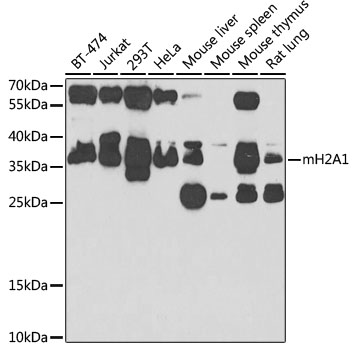
Western blot - mH2A1 Polyclonal Antibody
Western blot analysis of extracts of various cell lines, using H2AFY antibody at 1:1000 dilution.Secondary antibody: HRP Goat Anti-Rabbit IgG (H+L) at 1:10000 dilution.Lysates/proteins: 25ug per lane.Blocking buffer: 3% nonfat dry milk in TBST.Detection: ECL Basic Kit .Exposure time: 90s.
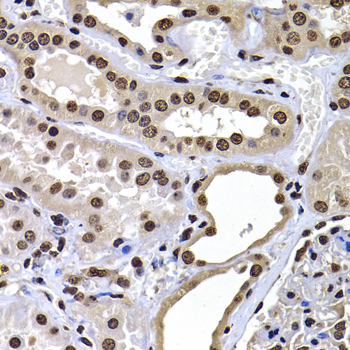
Immunohistochemistry - mH2A1 Polyclonal Antibody
Immunohistochemistry of paraffin-embedded human kidney using mH2A1 antibody at dilution of 1:100 (40x lens).
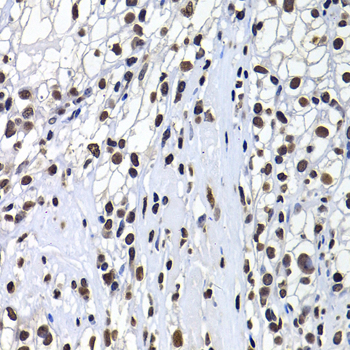
Immunohistochemistry - mH2A1 Polyclonal Antibody
Immunohistochemistry of paraffin-embedded human kidney cancer using mH2A1 antibody at dilution of 1:100 (40x lens).
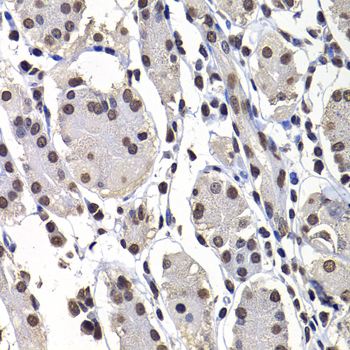
Immunohistochemistry - mH2A1 Polyclonal Antibody
Immunohistochemistry of paraffin-embedded human stomach using mH2A1 antibody at dilution of 1:100 (40x lens).
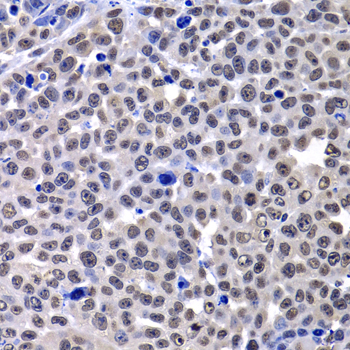
Immunohistochemistry - mH2A1 Polyclonal Antibody
Immunohistochemistry of paraffin-embedded mouse lung cancer using mH2A1 antibody at dilution of 1:100 (40x lens).

Immunofluorescence - mH2A1 Polyclonal Antibody
Immunofluorescence analysis of U2OS cells using mH2A1 antibody . Blue: DAPI for nuclear staining.
-
Background
Variant histone H2A which replaces conventional H2A in a subset of nucleosomes where it represses transcription. Nucleosomes wrap and compact DNA into chromatin, limiting DNA accessibility to the cellular machineries which require DNA as a template. Histones thereby play a central role in transcription regulation, DNA repair, DNA replication and chromosomal stability. DNA accessibility is regulated via a complex set of post-translational modifications of histones, also called histone code, and nucleosome remodeling. Involved in stable X chromosome inactivation. Inhibits the binding of transcription factors, including NF-kappa-B, and interferes with the activity of remodeling SWI/SNF complexes. Inhibits histone acetylation by EP300 and recruits class I HDACs, which induces a hypoacetylated state of chromatin.; Isoform 1: Binds ADP-ribose and O-acetyl-ADP-ribose, and may be involved in ADP-ribose-mediated chromatin modulation. Increases the expression of genes involved in redox metabolism, including SOD3.; Isoform 2: Represses SOD3 gene expression.
Related Products / Services
Please note: All products are "FOR RESEARCH USE ONLY AND ARE NOT INTENDED FOR DIAGNOSTIC OR THERAPEUTIC USE"
